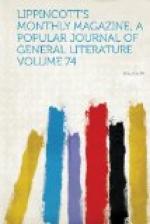to me to find that it cuts the sky (and what a
beautiful sky it is!) with a perfectly straight
and level line. A gentle, undulating foreground
broken into ravines, where patches of green velts
or fields, clumps of trees and early settlers’
houses nestle cosily down, guides the eye half-way
up the mountain. There the rounder forms
abruptly cease, and great granite cliffs rise,
bare and straight, up to the level line stretching
ever so far along. “It is so characteristic,”
and “You grow to be so fond of that mountain,”
are observations I have heard made in reply to
the carping criticisms of travelers, and already I
begin to understand the meaning of the phrases.
But you need to see the mountain from various
points of view and under different influences
of sun and cloud before you can take in its striking
and peculiar charms.
On each side of the straight line which is emphatically Table Mountain, but actually forming part of it, is a bold headland of the shape one is usually accustomed to in mountains. The “Devil’s Peak” is uncompromising enough for any one’s taste, whilst the “Lion’s Head” charms the eye by its bluff form and deep purple fissures. These grand promontories are not, however, half so beloved by Cape Colonists as their own Table Mountain, and it is curious and amusing to notice how the influence of this odd straight ridge, ever before their eyes, has unconsciously guided and influenced their architectural tastes. All the roofs of the houses are straight—straight as the mountain; a gable is almost unknown, and even the few steeples are dwarfed to an imperceptible departure from the prevailing straight line. The very trees which shade the Parade-ground and border the road in places have their tops blown absolutely straight and flat, as though giant shears had trimmed them; but I must confess, in spite of a natural anxiety to carry out my theory, that the violent “sou’-easters” are the “straighteners” in their case.
Cape Town is so straggling that it is difficult to form any idea of its real size, but the low houses are neat and the streets are well kept and look quaint and lively enough to my new eyes this morning. There are plenty of people moving about with a sociable, business-like air; lots of different shades of black and brown Malays, with pointed hats on the men’s heads: the women encircle their dusky, smiling faces with a gay cotton handkerchief and throw another of a still brighter hue over their shoulders. When you add to this that they wear a full, flowing, stiffly-starched cotton gown of a third bright color, you can perhaps form some idea of how they enliven the streets. Swarms of children everywhere, romping and laughing and showing their white teeth in broadest of grins. The white children strike me at once as looking marvelously well—such chubby cheeks, such sturdy fat legs—and all, black or white, with that amazing air of independence peculiar to baby-colonists. Nobody seems to mind




